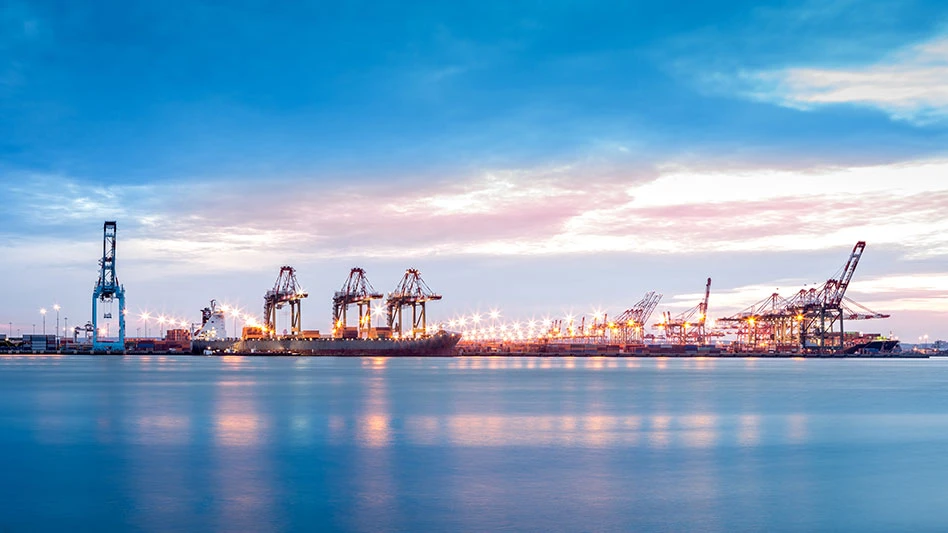
mandritoiu | stock.adobe.com
Tens of thousands of International Longshoremen’s Association (ILA) longshore workers at ports from Maine to Texas are prepared to strike to win a new contract with their employers represented by United States Maritime Alliance (USMX), Lyndhurst, New Jersey, saying they want wages that are commensurate with the billion-dollar profits earned by the ocean carriers.
The current six-year agreement between the ILA and USMX covers approximately 25,000 port workers employed in container and roll-on/roll-off operations at ports on the U.S. East and Gulf Coasts. It runs from Oct. 1, 2018, through Sept. 30, 2024.
RELATED: Updated: Labor-management standoffs could affect shipping sector
According to a news release issued by the ILA, which is based in North Bergen, New Jersey, a strike at all ILA ports on the Atlantic Coast and Gulf Coast appears likely to begin at 12:01 a.m. Oct. 1 as time is running out to get a new master contract agreement settled with USMX.
“A sleeping giant is ready to roar on Tuesday, Oct. 1, 2024, if a new master contract agreement is not in place,” ILA President Harold J. Daggett says. “My members have been preparing for over a year for that possibility of a strike.”
Instead of negotiating in good faith and respecting the ILA workforce, the ILA says, “USMX has chosen to engage in an ugly propaganda campaign designed to paint ILA longshore workers as ‘greedy’ and to also mask their own ineptitude and failure in these negotiations, dating back almost two years ago when they came into exploratory talks with the union and were totally unprepared.”
“USMX claims to offer industry-leading wages, however, their interpretation of ‘leading wages’ is polar opposite to ours,” the ILA writes in a letter to its membership earlier this week. “Inflation has completely eaten into any raises and wages. Everything is more expensive, even compared to six years ago. Our members are struggling to pay their mortgages and rent, car payments, groceries, utility bills, taxes and, in some cases, their children’s education. USMX’s corporate greed has made them delusional—profits over people. They have taken advantage of a low entry-wage and a tiered progression system for 30 years.”
The ILA notes the longshoring industry has unique working and scheduling conditions, writing, “Our rank-and-file members are not on salary—they work when the ships are docked at the berth, and only if their seniority affords them the opportunity.”
The union says its rank-and-file members will no longer accept master contracts that include small wage increases of a dollar or less with the employers sometimes asking for no yearly increases within the terms of the agreement.
“For over three decades, the annual increase in wages for ILA workers rose only a meager 2.02 percent per year, on average,” the ILA says.
The union also says it intends to recapture all monies earned through the industry’s container royalty, which it says originally was negotiated as a supplemental wage. Container royalty payments are intended to compensate longshoremen for decreased employment opportunities resulting from the use of containerized shipping. “That’s our members’ money, earned through hard work! Our members should never have to share their container royalty money with the ocean carriers, who are currently making record profits,” ILA says.
“USMX must face the reality that those years of spotty yearly increases of a dollar are now part of history,” ILA President Harold Daggett says. “Since USMX would rather leak our wage demands to the media instead of reporting on the record billion-dollar profits of their member companies, I can say ‘Yes, we are looking for a much higher percent increase in our wages.’”
He adds that USMX companies’ executives receive billion-dollar bonuses, so a $10-an-hour wage increase for ILA members shouldn’t be unreasonable. “The ILA longshore worker deserves it, and the companies have the money to pay it,” Daggett adds.
Associations seek intervention
A coalition of organizations representing manufacturers, farmers and agribusinesses, wholesalers, retailers, importers, exporters, distributors, transportation and logistics providers and other supply chain stakeholders sent a letter in June asking the White House to immediately work with both parties to resume contract negotiations and ensure there is no disruption to port operations and cargo fluidity.
That letter was followed by a second letter sent Sept. 17, which called for the Bide administration “to engage with the parties to quickly negotiate a new deal or agree to continue negotiations while keeping the ports open and cargo flowing. A strike at this point in time would have a devastating impact on the economy, especially as inflation is on the downward trend.”
However, according to Reuters, Biden does not intend to impose an 80-day cooling-off period under the federal Taft-Hartley Act if a new labor contract is not secured by Oct. 1, citing an administration official.
USMX asks ILA to return to bargaining
USMX issued a statement Sept. 17 that reads: “USMX is in strong agreement with the 177 trade associations who are calling for the immediate resumption of negotiations with the ILA to work out a new master contract agreement that recognizes their vital contributions while avoiding an unnecessary and disruptive strike that would be harmful to all parties.
"We have tremendous respect for the ILA and its members, but it is disappointing that we have reached this point where the ILA is unwilling to reopen dialogue unless all of its demands are met. The only way to resolve this impasse is to resume negotiations, which we are willing to do at any time. We understand and appreciate the concern from these trade associations, who realize what is at stake if negotiations are unable to progress, and we call on the ILA to return to bargaining so we can reach a new deal before the expiration of our current agreement, something we continue to believe is possible if the other side is willing to meet.”
Impacts of a possible strike
According to the National Association of Manufacturers, more than 68 percent of all containerized exports and more than 56 percent of containerized imports flow through East and Gulf Coast ports, representing an average daily trade value of more than $2.1 billion.
These ports also handle more than 91 percent of containerized imports, 76 percent of containerized vehicle exports and more than 54 percent of containerized vehicle imports.
For air and spacecraft, more than 77 percent of containerized exports and more than 51 percent of containerized imports go through these ports.
Latest from Recycling Today
- Lautenbach Recycling names business development manager
- Sebright Products partners with German waste management equipment company
- WasteExpo transitions to biennial format for enhanced experiences
- Study highlights progress, challenges in meeting PCR goals for packaging
- Washington legislature passes EPR bill
- PureCycle makes progress on use of PureFive resin in film trials
- New copper alloy achieves unprecedented high-temperature performance
- Gränges boosts profits and sales volume in Q1 2025





